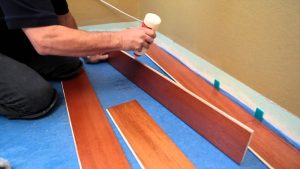Engineered wood flooring consists of a top layer of finished real wood, providing the appearance and texture of solid hardwood. Beneath this surface lies a core made of stacked plywood layers. This design allows the flooring to expand and contract with fluctuations in humidity, preventing the top hardwood layer from warping or cupping.
These properties make engineered wood flooring particularly suitable for environments like basements, where moisture levels can pose challenges for solid hardwood installation. Additionally, most types of engineered wood floors can be installed either as floating floors or glued down, simplifying the installation process for DIY enthusiasts. Once installed, the pre-finished top layer means the floor is immediately ready for use, requiring no additional sanding or sealing.
Facts About Engineered Wood Floors

- Engineered wood flooring offers several advantages over laminate, primarily due to its composition and durability. Unlike laminate, which is composed of synthetic materials, engineered wood has a genuine hardwood top layer bonded to multiple layers of plywood or high-density fiberboard. This construction makes it more resistant to dings and scratches, and in some cases, it can be sanded and refinished multiple times (typically 4 to 8 times depending on the thickness of the hardwood layer) to rejuvenate its appearance.
- The durability of engineered wood largely depends on the quality of the finishing product used and the characteristics of the hardwood layer. Higher quality finishes provide better protection against wear and tear. Additionally, the thickness of the hardwood layer affects how many times it can be sanded down and refinished.
- Installation options for engineered wood are diverse, including floating installations, glue-down applications, or nail-down methods, depending on the product and subfloor conditions. This versatility makes it suitable for various environments, including homes where mobility might necessitate removal and reinstallation in another location.
- The durability of engineered wood largely depends on the quality of the finishing product used and the characteristics of the hardwood layer. Higher quality finishes provide better protection against wear and tear. Additionally, the thickness of the hardwood layer affects how many times it can be sanded down and refinished.
- Installation options for engineered wood are diverse, including floating installations, glue-down applications, or nail-down methods, depending on the product and subfloor conditions. This versatility makes it suitable for various environments, including homes where mobility might necessitate removal and reinstallation in another location.
- While engineered wood generally costs more than laminate due to its authentic wood layer and enhanced durability, the investment often pays off in longevity and aesthetic appeal. It’s important to consider these factors when deciding between flooring options to ensure you choose the best fit for your needs and budget.
